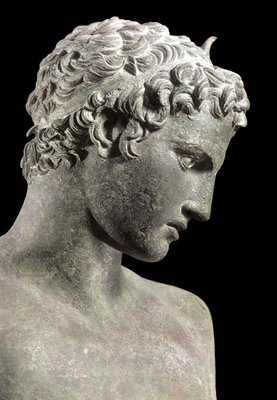My Grandmother and Antinous and Gay Sex
I think my preference for men rather than women came partly to consciousness through looking at photographs of Greek and Roman sculpture in the great Victoria Art books at my grandmother's house. Maybe not an uncommon story!
Sculptures like:
 Perseus Antikythera - Greek 350 BC
Perseus Antikythera - Greek 350 BC
 Marathonian Ephebe - Greek 330 BC
Marathonian Ephebe - Greek 330 BC Portrait of a Man - Greek 300 BC Temple of Apollo at Cyrene, Libya
Portrait of a Man - Greek 300 BC Temple of Apollo at Cyrene, Libya Head of a Wrestler
Head of a Wrestler
 Barberini Faun or Sleeping Satyr - 200 BC, found in Hadrian's Mausoleum (d.138AD
Barberini Faun or Sleeping Satyr - 200 BC, found in Hadrian's Mausoleum (d.138ADIn particular, I became intrigued by the sculptures and the story of Antinous (AD 110-130). Even more so after I visited Delphi in my early 20's, and saw the sculpture below first-hand:
 Delphi Antinous - 130-138 AD. Archaeological Museum, Delphi
Delphi Antinous - 130-138 AD. Archaeological Museum, Delphi
 Delphi Antinous - 130-138 AD. Archaeological Museum, Delphi
Delphi Antinous - 130-138 AD. Archaeological Museum, Delphi
Of Greek descent, Antinous was born in Bithynion-Claudiopolis, in what is now north-west Turkey. When the Emperor Hadrian passed through the Roman province of Bithynia in AD 124, the boy was taken into the imperial paedagogium. This institution trained suitable candidates to become palace or civil servants. However, between Hadrian's return to Italy in 125 and his next trip to Greece in 128, Antinous became the ruler's lover and favourite. The boy was 11 or 12 years of age. He was said to be beautiful, have great intelligence and a sharp wit, and be a great hunter and athlete. Tragically, he died at the early age of 20 - drowning in the Nile in October AD 130. It is unknown whether this was an accident, a suicide, a murder or a religious sacrifice.
Hadrian was grief-stricken. Antinous was deified and temples built to his cult. Obelisques were erected, and sculptures and busts produced in great numbers, appearing in cities all over the ancient world. A city of Antinioopolis was founded in Egypt.
Some rather blander later representations of Antinous:
 Barbarini Antinous
Barbarini Antinous
 Antinous Ecouen C18 Copy from Villa Adriana at Tivoli, Le Louvre
Antinous Ecouen C18 Copy from Villa Adriana at Tivoli, Le LouvreI quite fell in love with this hunk .... of marble! At the time. But have now and happily moved to more flesh and blood versions.
 Delphi Antinous - 130-138 AD. Archaeological Museum, Delphi
Delphi Antinous - 130-138 AD. Archaeological Museum, Delphi Delphi Antinous - 130-138 AD. Archaeological Museum, Delphi
Delphi Antinous - 130-138 AD. Archaeological Museum, Delphi








Actually my experience was the opposite of yours: I found such images, because I already was fascinated by the male body. Just as I'm still drawn to the kind of images that you and other bloggers post.
ReplyDeleteThese images gave me an official opportunity to explore my interest . . . just as my contemporaries seemed drawn to images of naked women.
Tom in USA
hi tom. u r right - i think there was a bit of both for me - a feedback loop. yeah, at my grandmother's it was socially acceptable to browse these photographs being antique sculpture. cheers. nick
ReplyDeletethinking bout it again, tom - i was between 8 and 10 at the time of The Books so maybe more of the coming to consciousness than of the seeking what i knew, but still obviously both were still involved. cheers again
ReplyDeleteA great book based on this love is Marguerite Yourcenar's Memoirs of Hadrian. Either in french or english.
ReplyDeletehi anon, yep, i've read it. in english - read french but not well. cheers. nick
ReplyDeleteNick,
ReplyDeleteThe ancients had a comfort with the human body that the Christian world has lost. Even the Renaissance couldn't put it back. It's as though with the advent of Christinity, western man had eaten the same apple as Adam and Eve, and were thrown out of the garden.
Cheers,
Bruce
hi bruce. i agree and i think the Barberini Faun expresses this idea perfectly - it still makes me slightly uneasy with it's open sexuality. cheers. nick
ReplyDelete